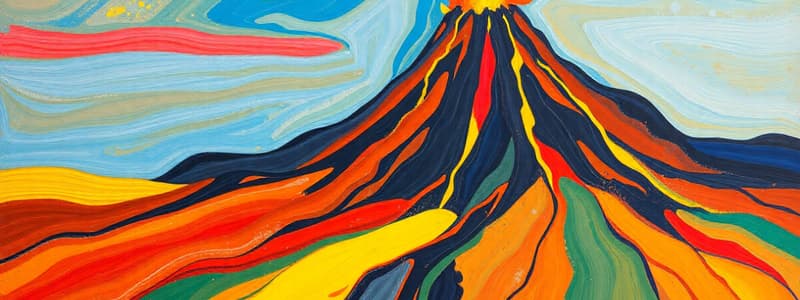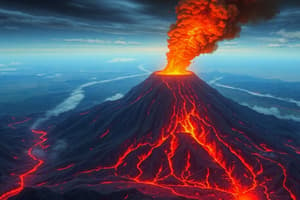Podcast
Questions and Answers
What is magma?
What is magma?
- Molten rock that is ejected from a volcano
- A mineral found in volcanic regions
- A type of volcanic gas
- Hot liquid rock under the Earth’s surface (correct)
A cinder cone volcano is considered the most complex type of volcano.
A cinder cone volcano is considered the most complex type of volcano.
False (B)
What is the term for the basin-like depression over a vent at the summit of a volcano?
What is the term for the basin-like depression over a vent at the summit of a volcano?
Crater
A ______ is an underground pool of liquid rock found beneath the earth’s crust.
A ______ is an underground pool of liquid rock found beneath the earth’s crust.
Match the type of volcano with its description:
Match the type of volcano with its description:
Which of the following describes a hotspot?
Which of the following describes a hotspot?
Lahars are characterized as fast-moving flows of volcanic debris and water.
Lahars are characterized as fast-moving flows of volcanic debris and water.
What generates geothermal energy?
What generates geothermal energy?
An ______ volcano has erupted at least once in the past 10,000 years.
An ______ volcano has erupted at least once in the past 10,000 years.
What defines a potential active volcano?
What defines a potential active volcano?
Flashcards
What is a volcano?
What is a volcano?
A mountain with an opening, or vent, that connects to a pool of molten rock below the Earth's surface.
What is magma?
What is magma?
Hot, liquid rock found beneath the Earth's surface.
What is lava?
What is lava?
Magma that has erupted onto the Earth's surface.
What is a magma chamber?
What is a magma chamber?
Signup and view all the flashcards
What is a conduit?
What is a conduit?
Signup and view all the flashcards
What is the summit of a volcano?
What is the summit of a volcano?
Signup and view all the flashcards
What is a crater?
What is a crater?
Signup and view all the flashcards
What are active volcanoes?
What are active volcanoes?
Signup and view all the flashcards
What are inactive volcanoes?
What are inactive volcanoes?
Signup and view all the flashcards
What are potentially active volcanoes?
What are potentially active volcanoes?
Signup and view all the flashcards
Study Notes
Volcanism and Volcanoes
- Volcanism is a phenomenon connected with volcanic activity.
- A volcano is a mountain that opens downward to a pool of molten rock below the Earth's surface.
- Magma is hot liquid rock beneath the Earth's surface.
- Lava is magma that erupts through the Earth's surface.
- Hotspots are regions of high volcanic activity not located at plate boundaries.
Parts of a Volcano
- Magma Chamber: A large underground pool of liquid rock beneath the Earth's crust.
- Vent: The opening through which an eruption takes place.
- Crater: A basin-like depression over a vent at the summit of the cone.
- Conduit: A channel or pipe conveying liquid materials, such as magma.
- Summit: The highest point or apex of the volcano.
- Ash Cloud: Expelled into the atmosphere, composed of pulverized rock and glass created during eruption.
- Volcanic Bombs: Chunks of lava blasted into the air that solidify before hitting the ground.
- Pyroclastic Flow: Fast-moving flows of hot ash, rock, and gas.
- Lahar: Also called mudflows; a flowing mixture of volcanic debris and water.
Types of Volcanoes Based on Structure
- Cinder Cone: The simplest type of volcano.
- Composite Volcano: Made of alternating layers of pyroclastic materials and solidified lava flows.
- Shield Volcano: A broad, gently sloping landform built by many layers of low-viscosity lava flows.
- Volcanic Dome: A rounded, steep-sided mound formed by small, bulging masses of lava (primarily dacite or rhyolite).
- Super Volcano: Known for producing the largest eruptions on Earth.
- Submarine Volcano: Created when magma erupts in underwater fissures.
- Subglacial Volcano: Formed by eruptions beneath the surface of a glacier.
Volcanoes Based on Activity
- Active Volcanoes: Have had at least one eruption in the last 10,000 years.
- Inactive Volcanoes: Have not erupted for the last 10,000 years and are not expected to erupt again.
- Potentially Active Volcanoes: Have no records of volcanic activity but are morphologically young-looking.
Geothermal Energy
-
Geothermal energy is generated when heat from within the Earth changes water into steam.
-
Geo- means earth, and therme- means heat
-
Types of geothermal power plants include dry steam, flash steam, and binary cycle power plants.
-
Geothermal Advantages:
- Eco-friendly
- High reliability
-
Geothermal Disadvantages:
- Limited accessibility
- Financial constraints
- Possible pollution
Studying That Suits You
Use AI to generate personalized quizzes and flashcards to suit your learning preferences.




